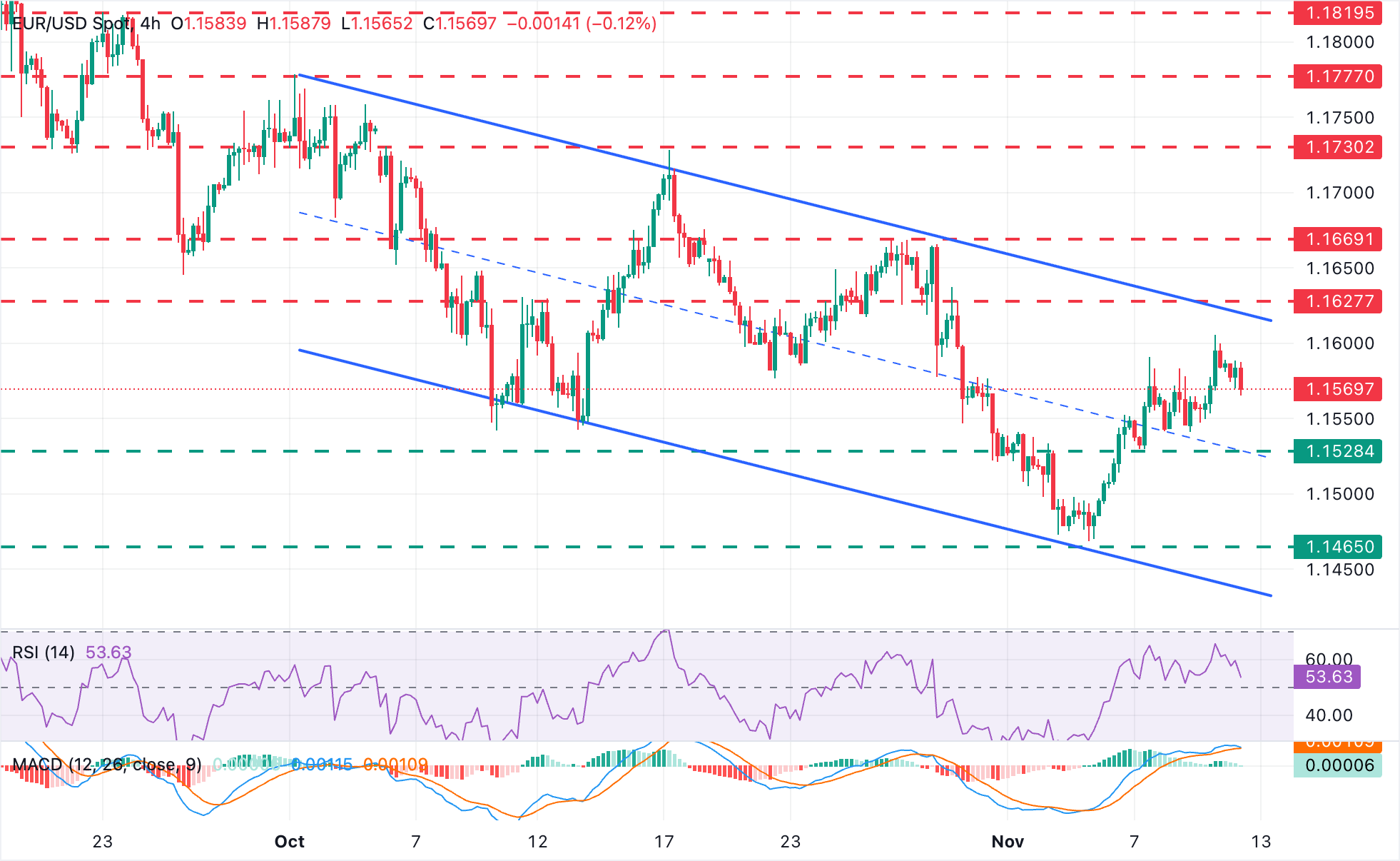
- The Euro eases to 1.1575 but remains trading within the previous day's range.
- German inflation figures confirm that price pressures moderated in October.
- US private employment data added reasons for the Fed to cut interest rates further in December.
EUR/USD shows marginal losses on Wednesday, trading at session lows near 1.1670 at the time of writing, after peaking above 1.1600 on Tuesday. Investors are reluctant to take excessive risks during the European session, awaiting the US Congress to pass the bill that will restore the US government funding, and the release of a batch of US official figures, for a better assessment of the country's economic momentum.
Germany's Harmonized Index of Consumer Prices (HICP), released earlier on Wednesday, confirmed the preliminary estimations, revealing that consumer inflation remains steady in October at levels broadly in line with the European Central Bank's (ECB) target for price stability. Wholesale Price Index MoM ticked up last month, according to data by Destatis. All in all, endorsing the central bank's monetary policy stance.
Figures released by ADP on Tuesday showed a net loss in private employment of 11,250 jobs in the four weeks ending October 25. The report restated the deterioration of the US labour market, adding pressure on the Federal Reserve (Fed) to lower borrowing costs further at its December meeting, and weighed down on the US Dollar.
In Wednesday's economic calendar, ECB Vice President Luis De Guindos and board member Isabel Schnabel will provide some distraction during the European session, while in the US, a slew of Fed speakers might comment on the latest news on employment and give further insight into the bank's rate path.
Euro Price Today
The table below shows the percentage change of Euro (EUR) against listed major currencies today. Euro was the strongest against the Japanese Yen.
| USD | EUR | GBP | JPY | CAD | AUD | NZD | CHF | |
|---|---|---|---|---|---|---|---|---|
| USD | 0.10% | 0.29% | 0.50% | 0.04% | -0.08% | 0.00% | -0.11% | |
| EUR | -0.10% | 0.20% | 0.39% | -0.06% | -0.18% | -0.10% | -0.21% | |
| GBP | -0.29% | -0.20% | 0.20% | -0.25% | -0.37% | -0.29% | -0.40% | |
| JPY | -0.50% | -0.39% | -0.20% | -0.46% | -0.58% | -0.50% | -0.61% | |
| CAD | -0.04% | 0.06% | 0.25% | 0.46% | -0.13% | -0.05% | -0.15% | |
| AUD | 0.08% | 0.18% | 0.37% | 0.58% | 0.13% | 0.08% | -0.03% | |
| NZD | -0.00% | 0.10% | 0.29% | 0.50% | 0.05% | -0.08% | -0.11% | |
| CHF | 0.11% | 0.21% | 0.40% | 0.61% | 0.15% | 0.03% | 0.11% |
The heat map shows percentage changes of major currencies against each other. The base currency is picked from the left column, while the quote currency is picked from the top row. For example, if you pick the Euro from the left column and move along the horizontal line to the US Dollar, the percentage change displayed in the box will represent EUR (base)/USD (quote).
Daily digest market movers: The US Dollar weakens as Fed easing hopes grow
- The US Dollar is showing a mild bearish tone this week, with investors assuming that official US data will force Fed policymakers to prioritize the labour market over inflation, which confirms the need for a further interest rate cut in December. The US Dollar is extending its pullback from last week's highs, and the Euro (EUR) is drawing support from that.
- German inflation data released on Wednesday confirmed that the HICP grew at a 0.3% pace in October and at 2.3% in the last 12 months, slightly below the 2.4% yearly inflation seen in September.
- Likewise, the German Consumer Price Index accelerated to 0.3% in October from 0.2% in September, although the yearly rate eased to 2.3% from the previous month's 2.4% reading.
- Wholesale Price Index, on the other hand, grew 0.3% in October in Germany, from 0.2% in September, beating expectations of a 0.1% growth. Year-on-year, the index eased to 1.1% from 1.2% in the previous month.
- The US ADP Employment Change 4-week average revealed that businesses shed an average of 11,250 jobs per week up to October 25, providing further reasons for Fed doves to cut interest rates further.
- In Europe, the German ZEW Survey disappointed market expectations on Tuesday. The sentiment about the German economic outlook declined to 38.5 in November from 39.3 in October, against expectations of an improvement to 40. The Current Situation has improved to -78.7 from -80, yet short of the market expectations of a -77.5 reading.
Technical Analysis: EUR/USD approaches trendline resistance at 1.1615

EUR/USD has been appreciating continuously during the last five days. Technical indicators on the 4-hour chart are pointing higher, with the Relative Strength Index (RSI) in the area of 60 and the Moving Average Convergence Divergence (MACD) printing green histogram bars, although bulls are likely to be challenged above 1.1600.
Price action is nearing the top of the descending channel from early October highs, now around 1.1615, which will meet the price near a previous support, in the area of 1.1620-1.1625 (October 28 low). The pair should break those levels to cancel the broader bearish trend and shift the focus towards the October 28 and 29 highs near the area of 1.1670.
Downside attempts are being contained above the 1.1575 session lows for now. Further down, EUR/USD might find support at the 1.1530-1.1540 area (near November 7, 10 lows) ahead of the 1.1500 psychological level and the key support at the November 5 low around 1.1470.
Euro FAQs
The Euro is the currency for the 20 European Union countries that belong to the Eurozone. It is the second most heavily traded currency in the world behind the US Dollar. In 2022, it accounted for 31% of all foreign exchange transactions, with an average daily turnover of over $2.2 trillion a day. EUR/USD is the most heavily traded currency pair in the world, accounting for an estimated 30% off all transactions, followed by EUR/JPY (4%), EUR/GBP (3%) and EUR/AUD (2%).
The European Central Bank (ECB) in Frankfurt, Germany, is the reserve bank for the Eurozone. The ECB sets interest rates and manages monetary policy. The ECB’s primary mandate is to maintain price stability, which means either controlling inflation or stimulating growth. Its primary tool is the raising or lowering of interest rates. Relatively high interest rates – or the expectation of higher rates – will usually benefit the Euro and vice versa. The ECB Governing Council makes monetary policy decisions at meetings held eight times a year. Decisions are made by heads of the Eurozone national banks and six permanent members, including the President of the ECB, Christine Lagarde.
Eurozone inflation data, measured by the Harmonized Index of Consumer Prices (HICP), is an important econometric for the Euro. If inflation rises more than expected, especially if above the ECB’s 2% target, it obliges the ECB to raise interest rates to bring it back under control. Relatively high interest rates compared to its counterparts will usually benefit the Euro, as it makes the region more attractive as a place for global investors to park their money.
Data releases gauge the health of the economy and can impact on the Euro. Indicators such as GDP, Manufacturing and Services PMIs, employment, and consumer sentiment surveys can all influence the direction of the single currency. A strong economy is good for the Euro. Not only does it attract more foreign investment but it may encourage the ECB to put up interest rates, which will directly strengthen the Euro. Otherwise, if economic data is weak, the Euro is likely to fall. Economic data for the four largest economies in the euro area (Germany, France, Italy and Spain) are especially significant, as they account for 75% of the Eurozone’s economy.
Another significant data release for the Euro is the Trade Balance. This indicator measures the difference between what a country earns from its exports and what it spends on imports over a given period. If a country produces highly sought after exports then its currency will gain in value purely from the extra demand created from foreign buyers seeking to purchase these goods. Therefore, a positive net Trade Balance strengthens a currency and vice versa for a negative balance.








